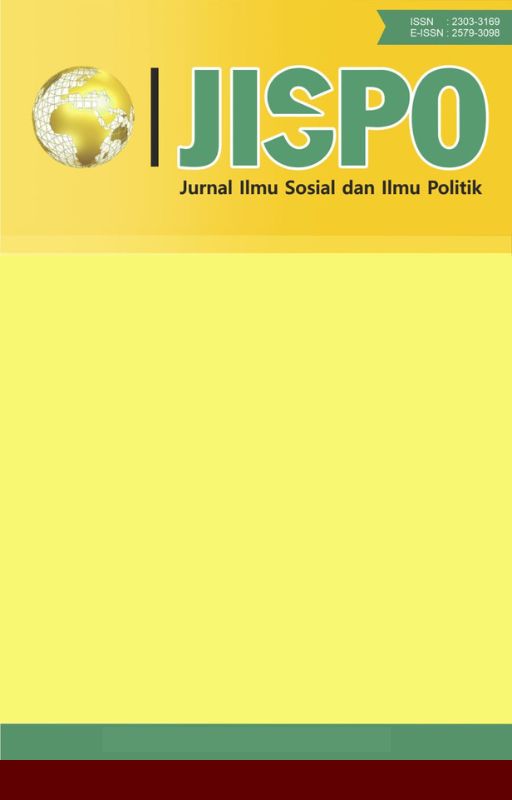ANALISIS FAKTOR EKSTERNAL DAN FAKTOR INTERNAL KETTNER DALAM ORGANISASI LAYANAN SOSIAL RIFKA ANNISA WOMEN CRISIS CENTER
DOI:
https://doi.org/10.15575/jispo.v9i1.4148Keywords:
Kettner Internal External Factor, Human Service Organization, Rifka Annisa Women Crisis CenterAbstract
The National Women's Commission states that Domestic Violence is always the most frequent case every year. Case data from Rifka Annisa also says that the number of violence against wives has always been the highest number of other cases of violence, namely 216 in 2017 which were successfully reported. The urgency of the case of violence against the earthquake has made the Rifka Annisa Women Crisis Center Institution must adapt to various changes in the environment and develop other strategies as needed. In this writing, Kettner's internal and external factors were explained to the Rifka Annisa institution. Internal speaking factors start from the vision-mission, Organizational Operating System, Organizational Plan, Human Resources, and Technology Resources, while external factors see economic, sociological, political and technological factors. Kettner sees that these internal and external factors influence each other so it is necessary to map so that the institution's consistency in achieving excellence in service is maintained. Here the research method uses literature studies from journals and scientific articles relevant to this study. The study shows that the Rifka Annisa Institute is very consistent with the vision, mission and objectives of the institution and is very progressive towards service programs for victims of domestic violence.References
Andriyani, F. (2013). Kontribusi Rifka Annisa Women’s Crisis Center Yogyakarta Dalam Penanganan Tindak Pidana Kekerasan Dalam Rumah Tangga. Skripsi Fakultas Syari’ah dan Hukum, Universitas Islam Negeri Yogyakarta.
Annisa, R. (2012). Kekerasan Terhadap Perempuan Berbasis Gender. Yogyakarta: The Global Fund And Women.
Anto, A. H. F. S. & Muhammad, A. H. (2017). Meningkatkan Sustainabilitas Organisasi Nirlaba Dengan Model Manajemen Dual Core. Jurnal ABDIMAS, 21(2), 87-95
Hasyim, Wakhit. (2016). Gerakan Sosial Baru dan Rifka Annisa: Sebuah Refleksi. http://rifka- annisa.org Diakses 20/12/2018 pukul 06.30.
Istiqomah. (2017). Aral Terjal Menghadang Perempuan (Studi Pencegahan Kekerasan Bagi Perempuan Oleh LSM Rifka Annisa di Ngalang, Gunungkidul. Jurnal Pemberdayaan Masyarakat, 1(1), 161-181
Kettner, P. M. M., Robert M, Martin, Lawrence L. (2015). Designing and Managing Programs: An Effectiveness-Based Approach. Amerika Serikat: SAGE Publications
Lutfia, A. (2016). Pemberdayaan Perempuan Korban KDRT Dalam Pelaksanaan Pendampingan Berbasis Perspektif Gender di LSM Rifka Annisa Yogyakarta. Skripsi Universitas Negeri Yogyakarta.
Mayadewi, P. (2014). Perencanaan Kebutuhan Pengembangan System Informasi (Studi Kasus: Perpustakaan Kota XYZ). Jurnal Infotel, 6(1), 29-36
Putri, F. S. (2018). Kenapa Perempuan Bertahan dalam Hubungan yang Mengandung Kekerasan? https://www.bbc.com Diakses 20 12 2018 pukul 06.03.
Putri, R. S. (2018). Komnas Perempuan: KDRT Jadi Kasus Terbanyak Pada Perempuan http://nasional.tempo.com diakses 20/12/2018 jam 05:32.
Sugiyono. (2015). Memahami Penelitian Kualitatif. Bandung: Alfabeta.
Sutomo, S. (2007). Manajemen Organisasi Nirlaba. Jurnal Kesehatan Masyarakat Nasional, 1(4), 176-187.
Sari, A. L. (2017). The Role Of Social Workers In The Development Of Tourism Villages. JISPO: Jurnal Ilmu Sosial dan Ilmu Politik, 7(2), 1-23.
Trisnawibawa, A. (2017). Peranan Rifka Annisa Women’s Crisis Center dalam Menangani Kasus Kekerasan Seksual di Yogyakarta. Yogtakarta: Universitas PGRI Yogyakarta.
Downloads
Published
How to Cite
Issue
Section
License
Authors who publish their manuscripts in JISPO agree to the following terms:
- Authors retain copyright and grant the journal right of first publication with the work simultaneously licensed under a Creative Commons Attribution-ShareAlike 4.0 International License that allows others to share the work with an acknowledgment of the work's authorship and initial publication in this journal;
- Authors are able to enter into separate, additional contractual arrangements for the non-exclusive distribution of the journal's published version of the work (e.g., post it to an institutional repository or publish it in a book), with an acknowledgment of its initial publication in this journal; and
- Authors are permitted and encouraged to post their work online (e.g., in institutional repositories or on their websites) after publication process, or prior to and during the submission process, as it can lead to productive exchanges, as well as earlier and greater citation of published work (See The Effect of Open Access).


